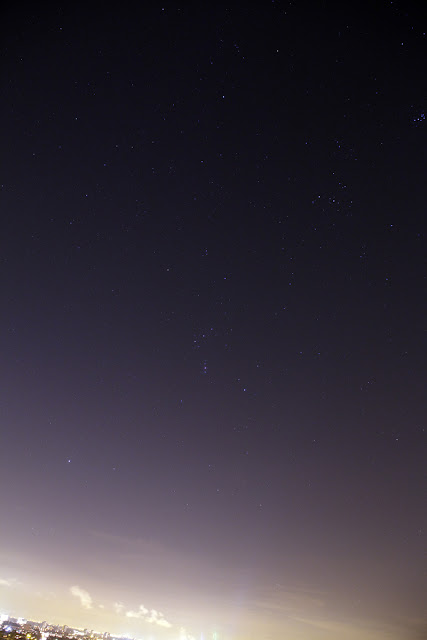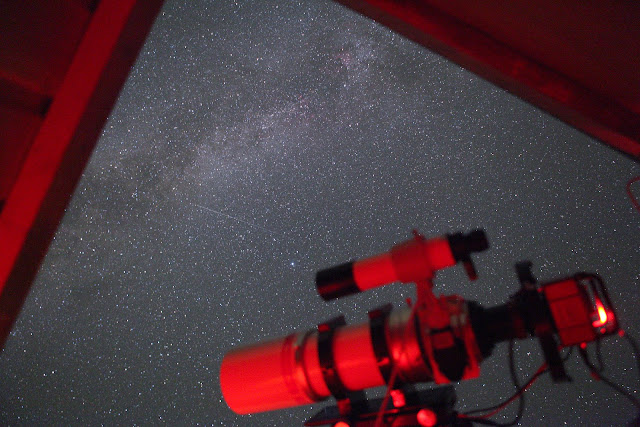Several "single shot" images made last summer in France with an astro-modified Canon 5D Mark II and Canon EF 24 -
70 mm f/2.8 L USM lens. Most of the images have been made at 24 mm
f/2.8 - f/4 at ISO 3200 or ISO 6400. Exposure times of 30
to 90 seconds.
Friday, 21 December 2012
Sunday, 28 October 2012
Messier 76, Little Dumbbell Nebula
This was my second night out with the Astrosib 250. Although the sky looked very clear during twilight, clouds appeared just when I wanted to start the first exposure. After a short while the clouds luckily disappeared. I run a script (in Nebulosity) to capture light through Ha (7 nm) en OIII filters (8.5 nm), which alternated with each other after each exposure. Exposure times were 20 minutes per subframe. Eventually 5 Ha subs and 6 OIII subs were usable to combine. Other subs were lost during haze and/or clouds and for the simple fact M76 disappeared behind the roof of my house.
Processing was partly done in Photoshop (CS6) and party done in PixInsight. For me it was the first time to really use PixInsight for processing and I liked it. The tools used were deconvolution (Richardson-Lucy, only on M76), AtrousWaveletTransform (noise reduction in the background) and DynamicBackgroundExtraction (slight correction for vignetting).
Shown are the full field of view (slightly cropped), crop at 50% resolution and crop at full resolution.
Processing was partly done in Photoshop (CS6) and party done in PixInsight. For me it was the first time to really use PixInsight for processing and I liked it. The tools used were deconvolution (Richardson-Lucy, only on M76), AtrousWaveletTransform (noise reduction in the background) and DynamicBackgroundExtraction (slight correction for vignetting).
Shown are the full field of view (slightly cropped), crop at 50% resolution and crop at full resolution.
Sunday, 23 September 2012
New telescope and first light pics
Recently I've received my new telescope: a 25 cm f/8 AstroSib Ritchey-Chrétien. This Russian made machine is built like a tank. A friend of mine called it "beautiful because of its ugliness".
Sky conditions were far from good last night, but good enough for a serious first light: the Gulf of Mexico (a.k.a. The Wall) @ F = 1420 mm f/5.7 (Astro-Physics CCDT67 reducer). Exposed 9x 20 min. with an SBIG ST-8300M and Baader 7 nm H-alpha filter. Full field of view and crop at full resolution.
Sunday, 15 July 2012
Jupiter Occultation
On the early morning of July 15, 2012, Jupiter was occulted by the moon. To witness this relatively rare event, I packed my car with astronomy equipment, went to bed early and set my alarm at 2:00 a.m. (my wife kindly requested me to sleep on the coach...). When the alarm went off, I quickly took a peek outside: rain. No worry, this was exactly what the weather forecast predicted. The skies would clear just before dawn, so time to go to a place outside town with a clear view to the east.
I arrived around 2:45 a.m.. The occultation would begin at (or around) 3:52 a.m. so I had time enough to set up the equipment. In the meantime it had stopped raining. I could already see several of the brighter stars. There were too many clouds to completely witness the start of occultation, but luckily for me, the final patches of clouds disappeared, so I was able to observe (and photograph) the rest of the event.
Technical details of the pictures can be found on my website.
I arrived around 2:45 a.m.. The occultation would begin at (or around) 3:52 a.m. so I had time enough to set up the equipment. In the meantime it had stopped raining. I could already see several of the brighter stars. There were too many clouds to completely witness the start of occultation, but luckily for me, the final patches of clouds disappeared, so I was able to observe (and photograph) the rest of the event.
Technical details of the pictures can be found on my website.
Labels:
Jupiter,
Moon,
occultation
Location:
Zoetermeer, The Netherlands
Saturday, 3 March 2012
La Palma - winter 2012
I've been on vacation to La Palma (one of the Canary Islands) for 2 weeks (February 17 - March 2). La Palma is also known as "La Isla Bonita" (the beautiful island). Why? Pictures speak louder than words...
Tuesday, 31 January 2012
Barnard's Loop
Recently a friend of mine made an adapter for me that enables me to fit my "old" Mamiya 645 medium format lenses on my "modern" ST-8300M CCD-camera. Because of the large flange focal distance of the Mamiya 645 lenses, there remains enough space to fit a filter wheel between the lens and the camera.
On the evening of January 31, 2012, I've tried out the adapter and it works! The adapter has been made a little shorter than calculated to be sure that the lenses can be focused in combination with filters in the light path. Instead of rotating the lens to the infinity mark, the lens has to be focused on a bright star (or object on the horizon).
First light was with a 45 mm f/2.8 lens and 7 nm H-alpha filter. The camera and lens were mounted on my Vixen Photoguider.
I took 12 images of 5 minutes each (unguided and rough polar alignment). Two images were wasted due to guiding errors, so here is 50 minutes of Barnard's Loop in Sweet Lake City's light pollution soup.
On the evening of January 31, 2012, I've tried out the adapter and it works! The adapter has been made a little shorter than calculated to be sure that the lenses can be focused in combination with filters in the light path. Instead of rotating the lens to the infinity mark, the lens has to be focused on a bright star (or object on the horizon).
First light was with a 45 mm f/2.8 lens and 7 nm H-alpha filter. The camera and lens were mounted on my Vixen Photoguider.
I took 12 images of 5 minutes each (unguided and rough polar alignment). Two images were wasted due to guiding errors, so here is 50 minutes of Barnard's Loop in Sweet Lake City's light pollution soup.
Saturday, 28 January 2012
City Astronomy
Dutch Astronaut André Kuipers took an image of the Netherlands (and Belgium) from space.
I live in the centre of the red cross hair: one of the most light polluted areas of the Netherlands. The bright yellow spots are caused by assimilation lights of greenhouses.
What does this mean for (amateur) astronomy? Well, kids who grow up in this part of the Netherlands cannot experience the splendour of the milky way. Most kids don't even know the existence of it, until they go on a holiday to a "dark" place. It also means that taking a picture of the Orion constellation with an exposure time of 2 minutes will lead to an overexposed image. The image below was exposed for 10 seconds at ISO 1600 with a Canon 5D Mark II and Canon EF 24-70 mm f/2.8 L USM lens at 25 mm f/5.6.

The only celestial objects in the sky that don't get disturbed by light pollution are the moon and planets. The following picture was taken on the same evening (January 27, 2012) at the public astronomical observatory of Rijswijk, located on top of a 12 storey high apartment building. You can see Jupiter on the top left and the moon and Venus at the lower right. On the foreground, a fellow astronomer is taking pictures of this conjunction. The high antennas are lightning rods. Exposed for 2.5 seconds with the same camera and lens at 24 mm f/5.6 and ISO 1600.
When the moon set, it disappeared in the clouds. Again taken with the same camera, but with a Mamiya 210 mm Sekor-C f/4 lens. Exposed for 4 seconds at f/8 and ISO 1600.
I live in the centre of the red cross hair: one of the most light polluted areas of the Netherlands. The bright yellow spots are caused by assimilation lights of greenhouses.
What does this mean for (amateur) astronomy? Well, kids who grow up in this part of the Netherlands cannot experience the splendour of the milky way. Most kids don't even know the existence of it, until they go on a holiday to a "dark" place. It also means that taking a picture of the Orion constellation with an exposure time of 2 minutes will lead to an overexposed image. The image below was exposed for 10 seconds at ISO 1600 with a Canon 5D Mark II and Canon EF 24-70 mm f/2.8 L USM lens at 25 mm f/5.6.

The only celestial objects in the sky that don't get disturbed by light pollution are the moon and planets. The following picture was taken on the same evening (January 27, 2012) at the public astronomical observatory of Rijswijk, located on top of a 12 storey high apartment building. You can see Jupiter on the top left and the moon and Venus at the lower right. On the foreground, a fellow astronomer is taking pictures of this conjunction. The high antennas are lightning rods. Exposed for 2.5 seconds with the same camera and lens at 24 mm f/5.6 and ISO 1600.
When the moon set, it disappeared in the clouds. Again taken with the same camera, but with a Mamiya 210 mm Sekor-C f/4 lens. Exposed for 4 seconds at f/8 and ISO 1600.
Subscribe to:
Comments (Atom)


































